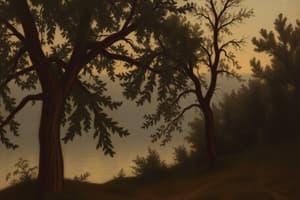Podcast
Questions and Answers
What are primary sources?
What are primary sources?
- Documents produced during the period being studied. (correct)
- Fossil remains that provide information about past life.
- Interpretations of historical events made during later periods.
- Oral traditions passed down through generations.
Which of the following is an example of a written source?
Which of the following is an example of a written source?
- A documentary film about ancient civilizations.
- A poem narrating a historical legend.
- A novel based on historical events.
- A manuscript recording laws from the past. (correct)
What defines oral sources of history?
What defines oral sources of history?
- They consist of visual media like photographs and films.
- They are verbal stories passed down through generations. (correct)
- They involve physical artifacts created by humans.
- They are documents from civilizations with written language.
Which category includes sources like palaces and sculptures?
Which category includes sources like palaces and sculptures?
What era does Prehistory end with?
What era does Prehistory end with?
Which type of source allows understanding the past by observing present-day practices?
Which type of source allows understanding the past by observing present-day practices?
Which type of sources can be considered audiovisual?
Which type of sources can be considered audiovisual?
Which source would be considered a secondary source?
Which source would be considered a secondary source?
What marks the beginning of Antiquity in historical categorization?
What marks the beginning of Antiquity in historical categorization?
Which period is characterized by the dominance of serfs and the feudal structure?
Which period is characterized by the dominance of serfs and the feudal structure?
Which of the following correctly reflects the duration of the Modern Age?
Which of the following correctly reflects the duration of the Modern Age?
What is associated with the mode of production known as 'Asian despotism'?
What is associated with the mode of production known as 'Asian despotism'?
What significant event marks the end of the Middle Ages?
What significant event marks the end of the Middle Ages?
Which mode of production is considered to have emerged in the Modern Era?
Which mode of production is considered to have emerged in the Modern Era?
Which of the following time frames approximately describes the duration of Antiquity?
Which of the following time frames approximately describes the duration of Antiquity?
What major transition occurred around 700 million years ago in the evolution of living beings?
What major transition occurred around 700 million years ago in the evolution of living beings?
Flashcards
Primary Source
Primary Source
A source created during the time period being studied.
Secondary Source
Secondary Source
An interpretation or analysis of primary sources.
Written Source
Written Source
Historical records written by humans who use writing.
Oral Source
Oral Source
Signup and view all the flashcards
Historical Source
Historical Source
Signup and view all the flashcards
Prehistory
Prehistory
Signup and view all the flashcards
Paleolithic Period
Paleolithic Period
Signup and view all the flashcards
Historical Periodization
Historical Periodization
Signup and view all the flashcards
Stone Age
Stone Age
Signup and view all the flashcards
Metal Ages
Metal Ages
Signup and view all the flashcards
Antiquity
Antiquity
Signup and view all the flashcards
Middle Ages
Middle Ages
Signup and view all the flashcards
Modern Age
Modern Age
Signup and view all the flashcards
Contemporary Age
Contemporary Age
Signup and view all the flashcards
Primitive Communism
Primitive Communism
Signup and view all the flashcards
Capitalism
Capitalism
Signup and view all the flashcards
Study Notes
Sources of History
- Sources of history can be diverse
- They are grouped into two categories based on their relationship to the past
- Primary Sources: Created during the time period being studied. Example: The Act of Independence of Peru
- Secondary Sources: Interpretations of primary sources. Example: A book about the War of the Pacific
- Sources based on information type
- Written Sources: Documents from people who can write, like chronicles, inscriptions, or books. Other examples include papyrus, parchment, clay tablets, and paper.
- Oral Sources: Verbal stories passed down through generations including legends, myths, poems, songs, and sayings. For example, "The Legend of Manco Cápac."
- Ethnological Sources: Learning about the past by observing present practices, like making chicha, observing rituals, or burying the dead.
- Monumental/Material Sources: Physical objects like palaces, temples, tools, pottery, and paintings made during the time period
- Audiovisual Sources: Sources like photographs, films, or recordings that offer insights into the past.
- Fossil remains: Information about human life from animal and plant fossils, including amount of time lived, diseases, and other details
Historical Periodization
- Two major periods for studying human history are marked out.
Studying That Suits You
Use AI to generate personalized quizzes and flashcards to suit your learning preferences.




